Quarterly report (July-Sept) on anonymous sources in newspapers
South Asia Check / October 8, 2020

During the past three months – between July 1 and September 30, 2020 – among the five major national dailies that we monitored, Nagarik used the most number of anonymous sources in its front page reports. It used a total of 322 anonymous sources in the front page reports during the period.
South Asia Check has, for the past several years, been tracking the use of anonymous sources in the news reports published on the front pages of six leading national dailies of Nepal – Kantipur, Nagarik, Annapurna Post, The Kathmandu Post, Republica and The Himalayan Times. While the first three are Nepali language newspapers, the last three are English dailies. But citing the Covid-19 pandemic, Republica has stopped the publication of its print edition as well as e-papers since April 16. Therefore, we have not included Republica this quarter as well.
After Nagarik, the dailies using the most number of anonymous sources were Kantipur, The Kathmandu Post, Annapurna Post and The Himalayan Times respectively. The Himalayan Times used the least number of anonymous sources, 69 in total, this quarter.
The front page reports of the five dailies used altogether 984 anonymous sources this quarter.
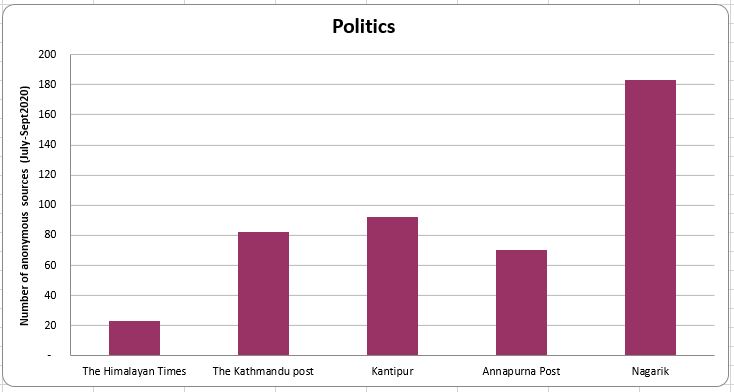


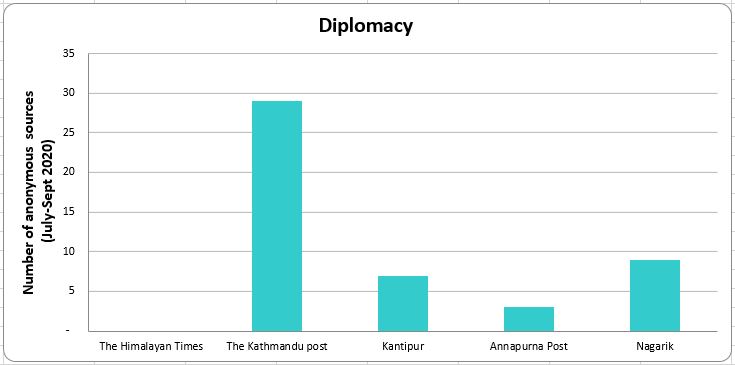

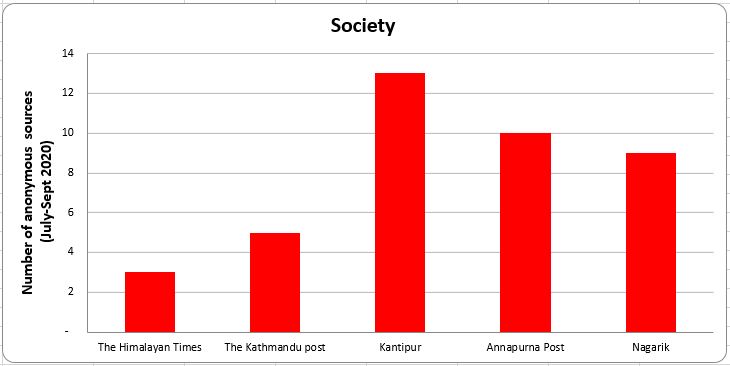
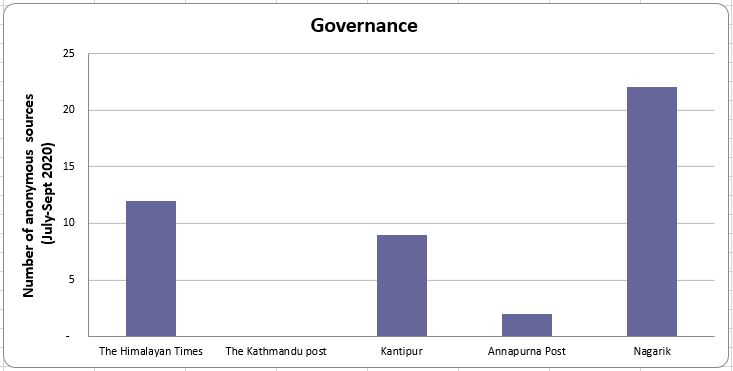




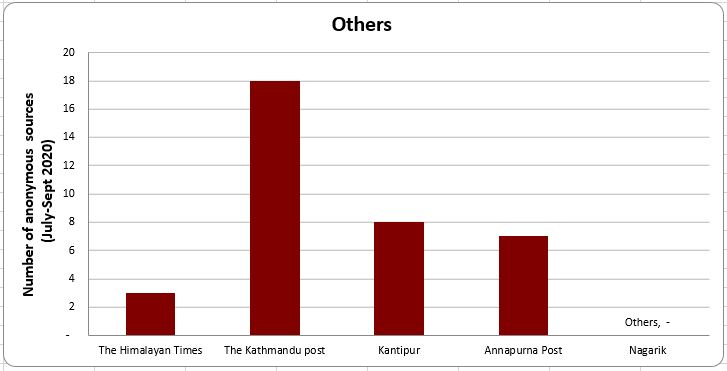

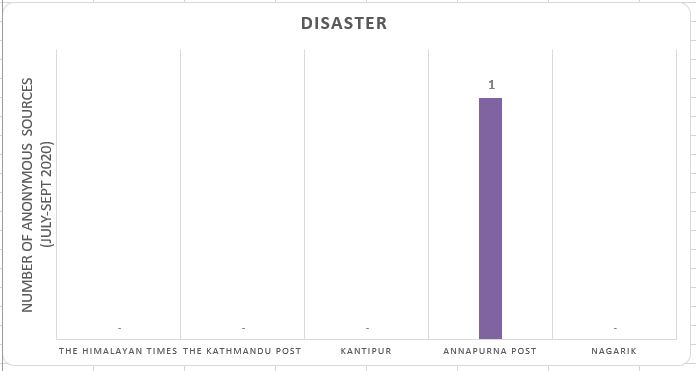
Most of the news reports on the front pages of the newspapers were about politics. Anonymous sources were mostly used in politics-related news reports (in 450 instances). Nagarik and Kantipur were the first and second national dailies respectively using the highest numbers of anonymous sources in their political reports; Nagarik used anonymous sources in 183 instances and Kantipur in 92 instances in such reports.
Health is the second topic in the Nepali newspapers where anonymous sources were used in highest numbers. During this period, anonymous sources were used in 159 instances in health-related news reports in the five newspapers.
Quoting anonymous sources in news reports is not an abnormal practice. Regarding the use of anonymous sources in news reports, Clause 4.8(1) of the ‘Journalist’s Code of Conduct, 2016 (first amendment 2019)’ issued by the Nepal Press Council states the following:
“Source should be quoted for the reliability of the news. However, while quoting the source, the name and identity of such source should be kept confidential so as to avoid any serious damage to the source.”
The identity of news source should be protected only if revealing the source’s identity can cause serious harm to him/her.
But some news reports published during this period have quoted anonymous sources even when there is no apparent need to do so.
For example, a report headlined “239 infected in the Valley itself” published in a Nepali-language daily stated, “We have contacted everyone who tested positive for the virus yesterday, but one or two persons switched off their phones after we reached them. We are still trying to contact them,” a contact tracer said. “The most difficult part of contact-tracing is to bring the infected persons to the hospital’s isolation rooms.”
Another report titled ‘They reside in Kathmandu, but official addresses are elsewhere’ in a Nepali-language daily states: “After we reached an infected woman with her address in Sunsari district, she was found to be living in a rented accommodation in Bhaktapur,” a health worker involved in contact tracing said. “People whose addresses were Dang and Lamjung were found living in Kathmandu.”
Likewise, a report headlined “Infected people lie about their addresses” published in a Nepali-language daily states: “After questioning we found that the person was an Indian national and sent him back,” said a staffer.
Another report headlined ‘Private (Labs) didn’t cut the PCR test fees’ published in a Nepali-language daily states: “We have already submitted a memo to the minister himself stating that we won’t be able to conduct PCR tests for Rs 2000,” said a private lab operator.
Similarly, a report in an English-language daily headlined “Hand washing stations were installed across the city to fight virus–but they have no water” states: “In some places sinks have been stolen,” according to a KUKL official.
Another report titled “Tender scrapped, urea supplier accuses govt of unfair treatment” in an English-language daily states:
“With the change in payment terms our foreign supplier refused to work as per the changes and didn’t deliver urea as promised earlier and it took us time to renegotiate the deal,” an official at Shailung, said.
Another report in an English-language daily headlined “Covid-19 pushes Gautam Buddha International Airport project further behind schedule” states:
“The contractor is saying that even if it sends its technicians, there must be a guarantee that they are not infected by the virus,” said the official. “No one can guarantee such things.”
The aforementioned use of anonymous sources is unjustified because disclosing the sources’ identities wouldn’t cause serious harm to the sources.
Haphazard use of the anonymous sources diminishes the credibility of news reports and the newspapers publishing such reports.
Click here to download the spreadsheet of anonymous sources statistics prepared by South Asia Check.
This material is copyrighted but may be used for any purpose by giving due credit to southasiacheck.org.
Comments
Latest Stories
- In Public Interest Covid-19 cases are low, but that’s not an excuse to avoid vaccination
- In Public Interest What is BF.7, the sub-variant that has the world by its grip?
- In Public Interest Threat of a new Covid-19 wave looms large amid vaccine shortage in Nepal
- In Public Interest As cases decline, Covid-19 test centres in Kathmandu are desolate lot
- In Public Interest Dengue test fee disparity has patients wondering if they’re being cheated
- In Public Interest As dengue rages on, confusion galore about what it is and what its symptoms are. Here’s what you need to know
In Public Interest
 Covid-19 cases are low, but that’s not an excuse to avoid vaccination
The Pfizer-BioNTech bivalent vaccines authorised by the Nepal Government provide better protection a...
Read More
Covid-19 cases are low, but that’s not an excuse to avoid vaccination
The Pfizer-BioNTech bivalent vaccines authorised by the Nepal Government provide better protection a...
Read More
- What is BF.7, the sub-variant that has the world by its grip?
- Threat of a new Covid-19 wave looms large amid vaccine shortage in Nepal
- As cases decline, Covid-19 test centres in Kathmandu are desolate lot
- Dengue test fee disparity has patients wondering if they’re being cheated
- As dengue rages on, confusion galore about what it is and what its symptoms are. Here’s what you need to know